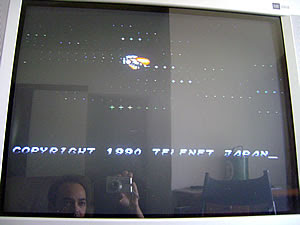Checkpoints OFF
4 Difficulty levels
12 Stages
Ship speed fixed
- - - - - - -
Developed by Raoghard
Published by Raoghard in 2010
There are days when you get home after work and you're so tired that all you want to do is spread out in a comfortable sofa and rest. I had one of these days last week. But what if you have an Xbox 360 controller on the couch while you're lying there doing nothing? Chances are you'll turn on the video game and browse through whatever new games there might be available for download. That day I came across this little shmup with hideous cover art called Avatar Squadron. I was too tired to get off my ass and go to the gym, so why not give it a try in the comfort of my couch as time dragged by? What I didn't expect was to beat the game in my first sitting.
Just like 98% of the Indie Games catalog in Xbox Live, presentation in Avatar Squadron is pretty bare bones. The differential here - and I've just learned there are other games that do the same (duh!) - is that your console avatar is taken as the pilot of the hero airplane. I guess there are people out there who're into this, but for me it's irrelevant. Much more amusing is the in-game dialogue between Beano the airplane and the control tower every time a stage starts. Yes, shooting stuff in a cute setting with some light humor is definitely not bad if you're tired and not feeling game for more complicated challenges.
In the course of all 12 stages of Avatar Squadron, the player faces variations of the same enemies over and over: biplanes in all sorts of formations, tanks, cars, dirigibles, missile launchers, helicopters. Backgrounds are presented with simple 3D rendering in cities, beaches and landscapes alternating between day and night. The overall style is cartoonish and deliberately lacks any level of detail, going instead for a fluffy, lighthearted tone that's completed by a soundtrack that tries to evoke a heroic epic feeling. Almost all sounds are also displayed as comic book-like onomatopoeias that luckily don't get in the way of the gameplay. The hero airplane is animated nicely, bending and swerving all around as it moves. Every stage starts with the airplane taking off and ends with either a boss fight or a landing sequence. Some of them drag a bit for being longer than others, but all things considered I think it's decently put together for such a budget title.
Simplicity aside, there are some neat ideas thrown into the gameplay. All you have as a weapon is a pea shot, with absolutely no progressive power ups. What you get as extras are temporary enhancements that vary in utility and duration, and these include a hammer, a 1-time smart bomb that detonates in contact with the ground, a deflector raquet, a pinball launcher, an invincibility cloud and a magnet to capture up to three tanks/cars to take advantage of their firepower. Whenever one of these items appears for the first time you get a briefing of how it works in the dialogue that precedes each stage.
Destroying a big enemy or a complete wave of smaller planes releases a medal, and by collecting 20 of these the player gets an extra life. Starting on the second level, every time you get hit you just have to tap the shot button really fast to recover from death and keep flying. This gets more and more difficult to pull off, so it's not possible to do it indefinitely. Scoring is heavily based on collecting the colored diamonds: yellow for 5.000, green for 10.000 and pink for 20.000 points each. As for cosmetic touches, the Y button makes the avatar wave and R1 changes the airplane color.
A squadron of four where only one pilot is actually awake
(courtesy of YouTube user yumyumentertainment)
(courtesy of YouTube user yumyumentertainment)
This is a kid's game, no doubt about it. If you get past the 1st stage chances are very high you'll get to the end without even thinking. Even in its functional interface this game is probably designed for 5-year olds. For example, stages are unlocked after being played and can be replayed at any time afterwards. The game refuses to reset any score you might have after a credit ends, so if you beat it and decide to go for another run you'll have the same score as before, even if you choose to start a "new game". If you want to start it over from scratch the only remedy is to access the memory manager and delete the save file. And I thought there wasn't anything more annoying than having to be online in order to play a game...
Avatar Squadron allows up to four simultaneous players, but they share the same life stock even though there's an individual scoring for each. That's just weird, and helps undermine a concept that could have been definitely better, as indicated by the stage reminiscent of the 80's. Played in shades of black & white, it has tons of music jokes in the dialogue and an A-Ha spoof as soundtrack.
Incredibly easy, almost worthless achievement, NORMAL difficulty, all 12 stages completed from scratch:














